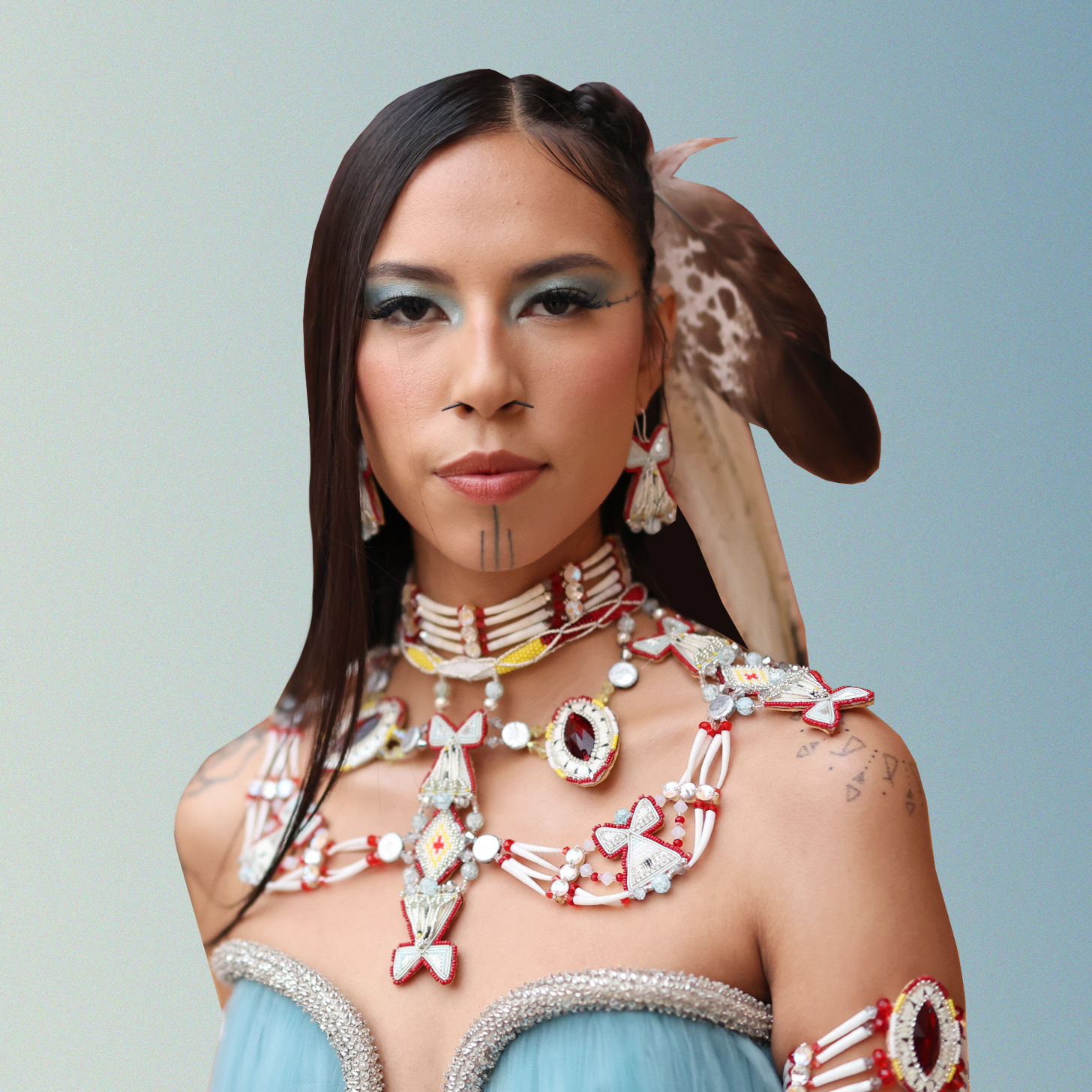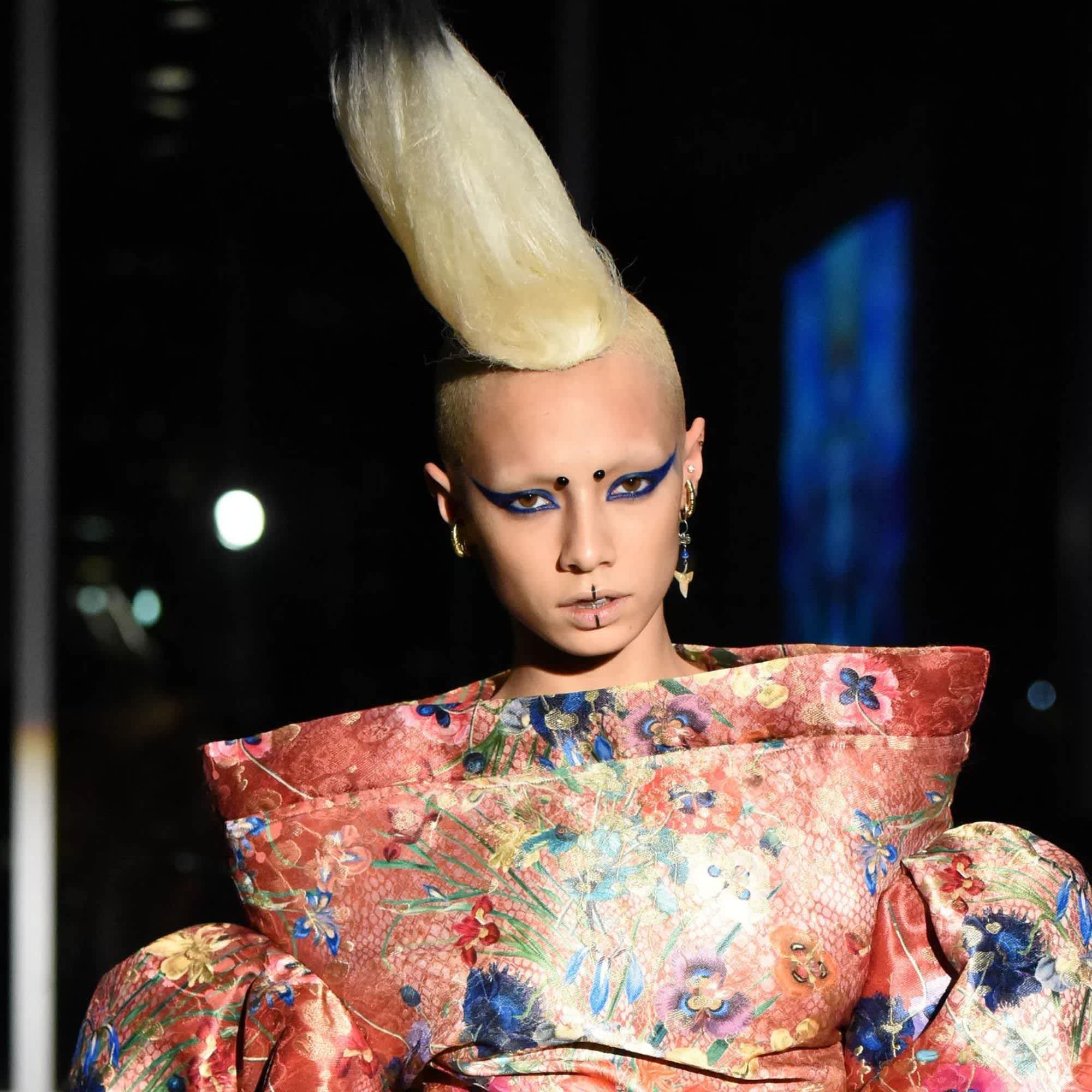
- POPSUGAR Australia
- Beauty
- Indigenous Women Are Reclaiming Their Culture, 1 Face Tattoo at a Time
Indigenous Women Are Reclaiming Their Culture, 1 Face Tattoo at a Time

Image Source: Getty / Matt Winkelmeyer and Photo Illustration by Becky Jiras
Last December, Inuit TikTok user Shina Nova got her first facial tattoos – a thin line etched vertically on her chin and two across both cheeks – called tunniit and kakiniit. (Kakiniit refers to the tattoo process and tradition; the face tattoos are referred to as tunniit.) “A lot of people told me I would regret it and that it would ruin my face, my ‘beauty,'” she wrote in the caption. “I don’t think so.”
Three months later, she revealed the meaning behind them in another video: “The one on my chin represents womanhood, and to honour all the beautiful women that helped guide me every single day. The ones on my cheeks, I keep them personal to myself. Inuit had tattoos as a rite of passage and to show their accomplishments, but it was also to beautify a woman. But in the 20th century, this practice was banned by the Christian missionaries, it was considered evil and demonic. People felt ashamed to have them, it was a forbidden practice. But today there are more and more Inuit getting their Tunniit and Kakiniit. We wear them proudly. It’s part of our identity, and it’s part of who I am. I’m proud to be an Inuit woman.”
More people are becoming aware of the traditional tattoo practices in Indigenous cultures thanks to people like Nova bringing them to the limelight. Supermodel Quannah Chasinghorse, who is Hän Gwich’in and Oglala Lakota, also has traditional facial tattoos – called Yidįįłtoo, which is a singular line running down the chin – as a marker for her culture. She’s helped bring Indigenous face tattoos to the masses, too: Chasinghorse made history in 2021 as the first Indigenous woman to walk for Chanel and attend the Met Gala, and she also starred in Zara’s recent “Skin Love” Campaign, helping to challenge and redefine the notion of beauty.
Holly Mititquq Nordlum, a tattoo artist of Iñupiaq background, is glad to see this tradition being brought to the public. “I’m so proud of those two women, educating and normalizing and reminding the world that we are still here and thriving despite continued attempts at genocide through every system they have placed upon us,” Nordlum says. “I think of them as sisters in the fight for equality for reparations and acknowledgement.”
Alaska and Canada are home to diverse Indigenous cultures that include facial tattoos, a practice that remained widespread and unchanged for millennia before being banned. Here, we’re delving into the storied history behind the tradition – and where it stands now.
The History of Facial Tattoos in Indigenous Cultures
For centuries, Alaskan Indigenous, First Nations, Inuit, and Métis members have had tattoos. Since they predate written history, no one knows for certain how far traditional tattooing goes back. According to “Tattoo Traditions of Native North America: Ancient and Contemporary Expressions of Identity” by Lars Krutak, they date back to at least 3,600 years of archaeological evidence. In 1986, an ivory mask of a heavily tattooed woman with numerous lineal facial tattoos was found on Devon Island, Nunavut. Krutak, a tattoo anthropologist, has studied tattoos from the prehistoric era and recent history, and the tattooing was exactly the same.
Then, from the late 1800s until the 1960s, thousands of Indigenous, Inuit, Métis, and First Nations children from Alaska and Canada were removed from their homes and placed in boarding schools. Not only did this removal take them away from their families and tribal communities, but often the schools and missionaries also tried to convert them to Christianity as a way to assimilate them to a Western way of life. They were banned from speaking their languages, wearing their traditional clothing, and practising customs like tattooing, which nearly disappeared in the early 20th century.
Designs, Meanings, and Cultural Significance
In the north, traditional tattooing practices can vary widely, ranging in style and name from one First Nation, Inuit, Métis, and Indigenous group to another, and can be specific to certain regions. Still, there are a few common themes. The designs can consist of dots, geometric triangular lines, shapes, and straight lines – each representing a rite of passage or significant event. Some other common markings found on the face are tattooed on the chin, the corner of the eyes, or on the forehead. One of the most common facial tattoos is three lines, starting from the lip and tattooed down to the chin.
Each pattern has symbolic meaning to the individual and serves a variety of purposes, often to celebrate and commemorate significant life events. Among Inupiat women, like in Nova’s case, tattoos can represent milestones, such as marriage, having children, or as a rite of passage such as entering womanhood. Each tattoo is closely tied to the cultural identity of the people; you could often tell what clan and family they belonged to by these markers. Before they were banned, you could look at a woman’s face and what region she was from, what her achievements were, and her place in the community.
Traditional Tattoo Methods and Tools
For centuries, women would get tattoos with needles made of bone or sinew soaked in suet, using thread-like material made from caribou sinew. It was soaked in seal oil and soot and poked with a needle, then sewed in the skin. Today, ink can be used, but many prefer the traditional methods of hand-poking or hand-stitching.
For example, Nordlum’s tattoos and designs both use hand-poking and hand-stitching methods, but no machines. This is a process that uses a needle to poke ink into the skin using a pin tool, which is mainly reserved for Inuit tattoos, whereas skin–stitching uses a needle and thread dipped into ink, using the needle to leave ink under the skin to leave a permanent design.
The Road to Reclaiming One’s Culture
Today, many women are working to preserve the tattoo techniques and to reconnect with what was almost entirely erased. Women like Hovak Johnson, an Inuit tattoo artist, decided to revive the practice with the Revitalization Project. She raised money to travel to communities across Canada and give traditional poke method tattoos to Inuit women, usually in exchange for a small gift like homemade earrings or a meal. She later documented her journeys to re-establish this tradition in a book called Reawakening Our Ancestors’ Lines.
There is an innate celebration in each of the markings and what we decide to tell others.
A growing number of Indigenous women tattoo artists are also using these traditions as a way to make a statement of pride and their culture, to remember their ancestors and history, and as a way to heal from colonization. Nordlum created the Tupik Mi apprenticeship program to revive the tradition of Inuit tattoos. The goal was to be a self-sustaining program. “So far it is working; lots of women come to us and want to do this work, but it takes a huge commitment to build these relationships, learn our history, and be able to communicate all that to the next generation. It’s not just about marking – it’s about history, activism, healing, storytelling, and being a healer.”
Thanks to these artists, traditional tattoos are reappearing in Alaskan and Canadian Indigenous communities. With their work, this tradition is now being rejuvenated after nearly being wiped out.
“[Facial tattoos] are reminders for the other and for us,” Nordlum says. “They’re healing and solidify the connection and commitment to your community. They are also personal accomplishments and markers of a woman’s life. There is an innate celebration in each of the markings and what we decide to tell others. It’s up to us. We can be proud. We can remind them we are still here to bring back the ceremony of traditional markings – and keep it for us, not our colonizers.”


